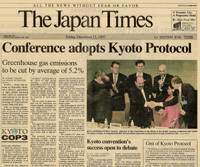The Kyoto protocol
The Kyoto Protocol to the United Nations Framework Convention on Climate Change strengthens the international response to climate change. Adopted by consensus at the third session of the Conference of the Parties (COP3) in December 1997, it contains legally binding emissions targets for Annex I (developed) countries for the post-2000 period. The EU and its Member States ratified the Kyoto Protocol in late May 2002.
By arresting and reversing the upward trend in greenhouse gas emissions that started in these countries 150 years ago, the Protocol promises to move the international community one step closer to achieving the Convention’s ultimate objective of preventing "dangerous anthropogenic [man-made] interference with the climate system".
The developed countries commit themselves to reducing their collective emissions of six key greenhouse gases by at least 5%. This group target will be achieved through cuts of 8% by Switzerland, most Central and East European states, and the European Union (the EU will meet its target by distributing different rates among its member states); 7% by the US; and 6% by Canada, Hungary, Japan, and Poland. Russia, New Zealand, and Ukraine are to stabilize their emissions, while Norway may increase emissions by up to 1%, Australia by up to 8%, and Iceland 10%. The six gases are to be combined in a "basket", with reductions in individual gases translated into "CO2 equivalents" that are then added up to produce a single figure.
Each country’s emissions target must be achieved by the period 2008-2012. It will be calculated as an average over the five years. "Demonstrable progress" towards meeting the target must be made by 2005. Cuts in the three most important gases – carbon dioxide (CO2), methane (CH4), and nitrous oxide (N20) - will be measured against a base year of 1990 (with exceptions for some countries with economies in transition).
Cuts in three long-lived industrial gases – hydrofluorocarbons (HFCs), perfluorocarbons (PFCs), and sulphur hexafluoride (SF6) - can be measured against either a 1990 or 1995 baseline. (A major group of industrial gases, chlorofluorocarbons, or CFCs, are dealt with under the 1987 Montreal Protocol on Substances that Deplete the Ozone Layer.)
Actual emission reductions will be much larger than 5%. Compared with emissions levels projected for the year 2000, the richest industrialized countries (OECD members) will need to reduce their collective output by about 10%. This is because many of these countries will not succeed in meeting their earlier non-binding aim of returning emissions to 1990 levels by the year 2000; their emissions have in fact risen since 1990. While the countries with economies in transition have experienced falling emissions since 1990, this trend is now reversing.
Therefore, for the developed countries as a whole, the 5% Protocol target represents an actual cut of around 20% when compared with the emissions levels that are projected for 2010 if no emissions-control measures are adopted.
Countries have a certain degree of flexibility in how they make and measure their emissions reductions. In particular, an international "emissions trading" regime is established allowing industrialized countries to buy and sell emissions credits amongst themselves. They will also be able to acquire "emission reduction units" by financing certain kinds of projects in other developed countries through a mechanism known as Joint Implementation. In addition, a "Clean Development Mechanism" for promoting sustainable development enables industrialized countries to finance emissions-reduction projects in developing countries and receive credit for doing so.
They pursue emissions cuts in a wide range of economic sectors. The Protocol encourages governments to cooperate with one another, improve energy efficiency, reform the energy and transportation sectors, promote renewable forms of energy, phase out inappropriate fiscal measures and market imperfections, limit methane emissions from waste management and energy systems, and protect forests and other carbon "sinks".
The Protocol advances the implementation of existing commitments by all countries. Under the Convention, both developed and developing countries agree to take measures to limit emissions and promote adaptation to future climate change impacts; submit information on their national climate change programmes and inventories; promote technology transfer; cooperate on scientific and technical research; and promote public awareness, education, and training. The Protocol also reiterates the need to provide "new and additional" financial resources to meet the "agreed full costs" incurred by developing countries in carrying out these commitments.
The Conference of the Parties (COP) of the Convention also serves as the meeting of the Parties (MOP) for the Protocol. This structure has been established to facilitate the management of the intergovernmental process. Parties to the Convention that are not Parties to the Protocol will be able to participate in Protocol-related meetings as observers.
The agreement is being reviewed. The Parties will take "appropriate action" on the basis of the best available scientific, technical, and socio-economic information. Talks on commitments for the post-2012 period are on-going [see UN Climate Change Conference 2007, 3rd Meeting of Parties (COP/MOP-3) to the Kyoto Protocol, Bali ]
Full text of the Kyoto Protocol
European Union ratifies the Kyoto Protocol - Press Release
The Kyoto Protocol and climate change - background InformationLabels: Kyoto Protocol


